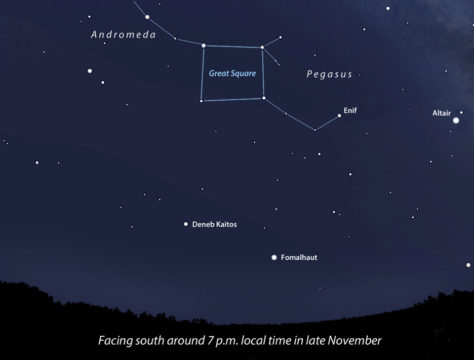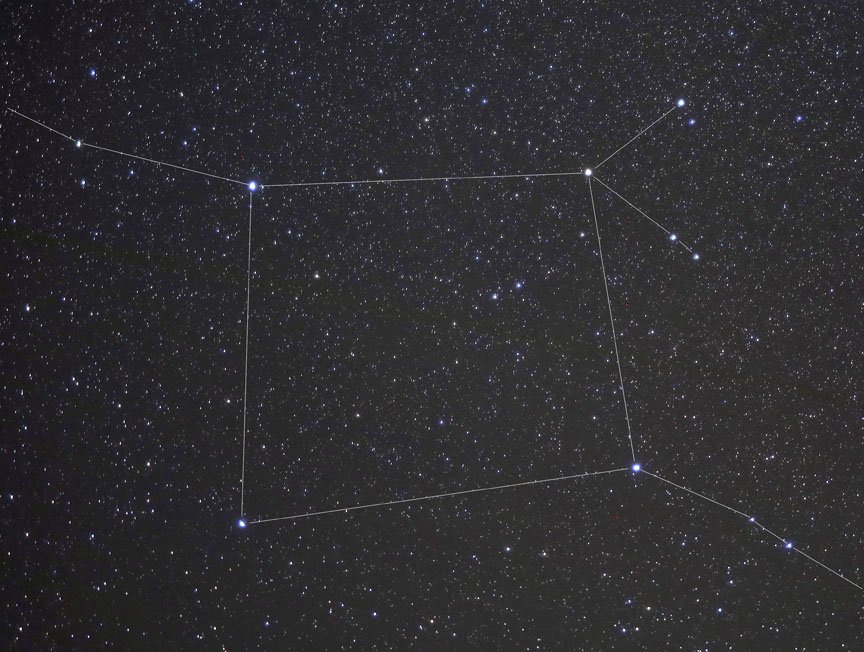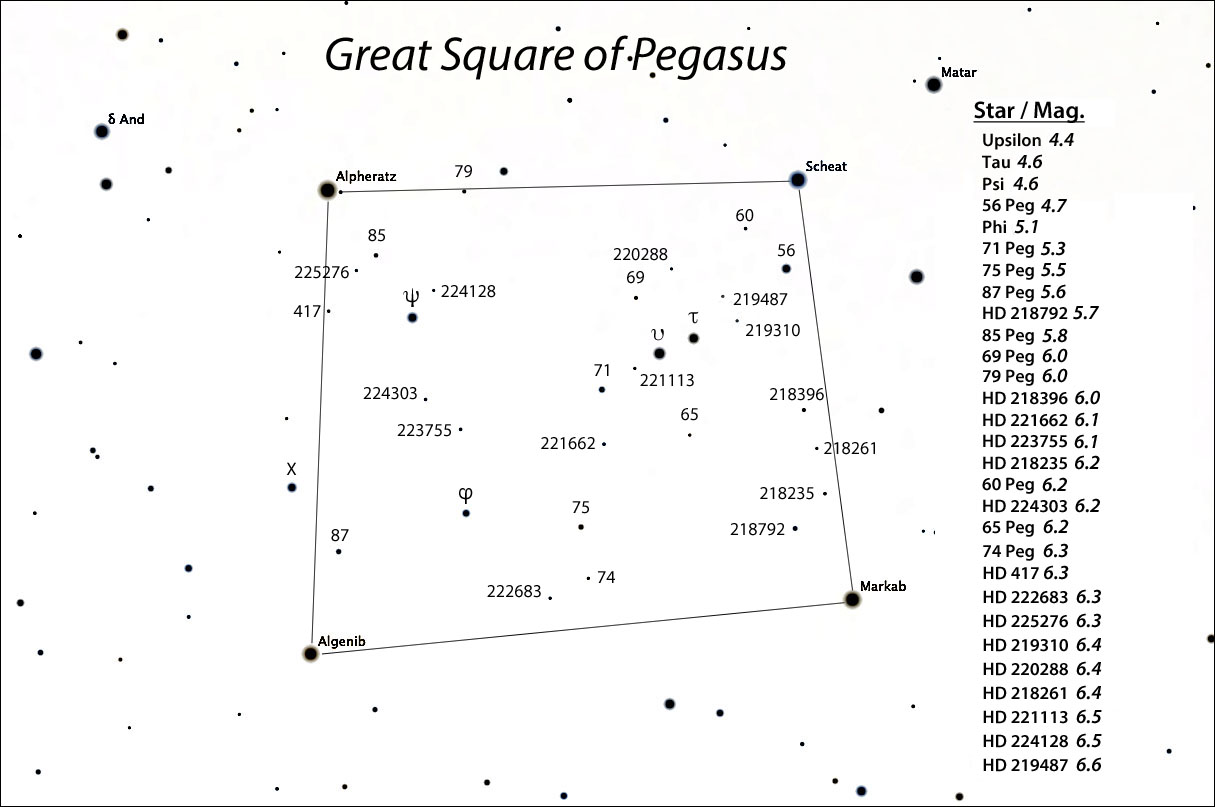Test the limits of your vision — and the darkness of your sky — by taking a plunge into the Great Square of Pegasus.

Stellarium
The Great Square of Pegasus frames a large, seemingly empty region in the sky on late autumn evenings. One of the best known asterisms, the Square is positioned due south at around 7 p.m. local time, as if extending an invitation to jump in. Let's do it.
Whether you're a novice or experienced observer, you're probably curious about how dark your sky is and how it compares to other locales. You can buy a Sky Quality Meter (SQM) to find out, or eyeball the situation by determining the limiting magnitude — the brightness of the faintest star visible. The Great Square is an excellent place to do this.
On a recent night, I sat in a folding chair with my binoculars and a star chart annotated with magnitudes down to 6.6 (see below). But don't suppose the binos were there so I could cheat. Binoculars are one of the most useful instruments a sky-watcher can own, and are a great aid when it comes to figuring out exactly where to look when attempting to glimpse stars at the limit of naked-eye visibility.
At first glance, my prospects looked grim — I could only discern two or three stars within the Square. In time my eyes adjusted to the darkness, and a calm determination set in as I prepared for the challenge of putting my vision to the test.

Bob King
From Bright to Dim
I easily found the Square's two brightest stars, Upsilon (υ) and Tau (τ) Pegasi (magnitudes 4.4 and 4.6, respectively), keeping each other company west of center. Observers in suburban areas with modest light pollution should be able to nab this duo, along with Psi (ψ) (4.6) and possibly 56 Pegasi (4.7). From my observing site, where the sky typically rates Class 3 on the Bortle Scale, these four stars posed no problem.
Dipping deeper, I soon found Phi (φ) Pegasi (magnitude 5.1) and left the Greek alphabet behind with 71 and 75 Pegasi (magnitudes 5.3 and 5.5). I tried to keep my averted vision powers in reserve, but 71 and 75 Pegasi forced me to engage this powerful observing technique to confirm my sightings. Like the final push to the top of a mountain peak, I knew the going was about to get even tougher. Most observers tend to regard naked-eye stargazing as a simple, relaxing pleasure, but I was finding this Pegasus project as challenging as any telescopic endeavor. Just kidding ... sort of.
My next target was 87 Pegasi (magnitude 5.6), which flittered in and out view. Ditto for HD218792 (5.7), located 2.7° northeast of 2nd-magnitude Alpha (α) Pegasi, better known as Markab. To find fainter stars, I played a sort of "fill in the blank" game in which the target star was missing from a triangle, line, or other shape, that also included brighter stars. Using this trick I was able to reach the oft-cited naked-eye limit of magnitude 6 by sighting HD218396. Could I go further?

Stellarium with additions by the author
I used binoculars to verify that I'd bagged HD223755 (magnitude 6.1) and 60 Pegasi (6.2), located 2.1° southeast of Scheat (β). I suspected two additional fainter stars in the Square, and dearly wanted to include Chi (χ) (easy at magnitude 4.8) in my count, but since the latter was located ¾° out of bounds, that would have been cheating. In the end I determined my limiting magnitude to be 6.2 and claimed 14 suns within the Great Square. That's hardly a record, but I never realized there were that many stars visible in the first place.
More than the results, I loved the quiet but dogged work of seeking a difficult targets and finding them. When the mind gives itself over to the hunt, it's flooded with an animal-like alertness that concentrates the senses and renews the spirit.
In an upcoming installment, we'll go a deeper to explore more than two dozen telescopic sights that beckon from this famous quadrangle.
 4
4









Comments
Jamie-Dillon
November 29, 2019 at 10:41 pm
https://nineplanets.org/estimating-limiting-magnitude/
Here's a set of triangles in constellations thru the sky, developed by a Finn once upon a time. Count the stars inside a triangle and come up with a limiting magnitude. Elegant system, highly reliable. Actually a lot more reliable over time than looking for progressively dimmer stars.
Same mental effect, Bob, sitting back and waiting to see where more stars soak into the retinas.
And of course I need to give credit to Bill Arnett and his ancient and amazing Nineplanets site.
You must be logged in to post a comment.
Bob KingPost Author
December 3, 2019 at 10:19 am
Hi Jamie,
Thank you for the link and suggestion.
You must be logged in to post a comment.
TomR
December 2, 2019 at 6:14 am
Hi Bob,
I like this kind of game, but I discovered only 5 stars (No 1-5 from your list). We have some light-pollution and I was not very patient, due to the cold.
Interesting, how you describe your feelings, when you concentrate your senses and renew your spirit. When we want to understand a person, we have to practice deep listening. When we want to understand the universe, we have to practice deep looking, but maybe this also a kind of deep listening?
Thomas, Austria, 49° N
You must be logged in to post a comment.
Bob KingPost Author
December 3, 2019 at 10:15 am
Hi Tom,
Five is better than none. Thank you for trying out this little observing project. And I really enjoyed your observation that deep looking might just be another form of listening. Very nice.
You must be logged in to post a comment.
You must be logged in to post a comment.